Bringing home an exotic pet snake for the first time can be exciting yet nervewracking! As beginners, it’s normal to have lots of questions swirling around about how to properly care for a corn snake. Will I be able to handle it? What should I feed it? Is my tank setup ok? This detailed care guide will walk you through everything you need to know about choosing, prepping for, feeding, handling techniques, health signs, and more to keep your corn snake healthy and happy for years to come!
Are Corn Snakes Good Beginner Snakes?
Corn snakes are highly recommended as excellent beginner pet snakes due to their generally calm and docile temperament. Unlike some species that tend to be nippy or jittery, corn snakes tend to move slowly and very rarely bite – especially when properly handled. Their care requirements are also less demanding compared to other snake species in terms of habitat temperature regulation and humidity needs. As long as you can provide a proper home environment and consistently meet their basic needs, corn snakes make fantastic starter pets even for children under adult supervision.
Some key reasons why corn snakes make great starter snakes:
- Docile calm temperament
- Tolerant of handling when tamed
- Hardier species with easier habitat needs
- Stay relatively small size (4 to 6 feet)
- Low cost snake to purchase and feed
- Fun beginner species to breed
As an owner, you’ll find corn snakes to have interesting behaviors and plenty of personality. By nature they are somewhat shy, burrowing reptiles but once settled into a habitat can become quite interactive and curious around their domain. With the proper habitat setup and consistent gentle handling, corn snakes quickly tame down and make for delightful low maintenance pets with an average lifespan of 15 to 20+ years.
Selecting Your Corn Snake
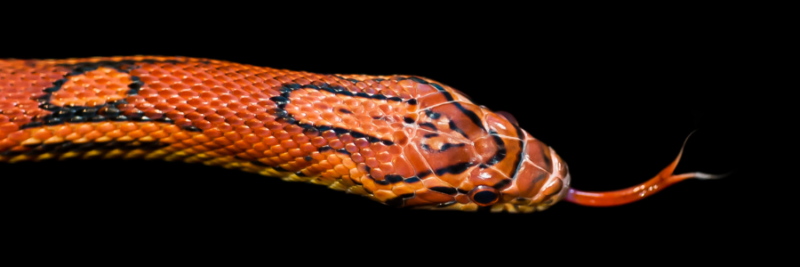
No matter your color preference, look for these signs of a healthy snake when making your selection:
- Bright, alert eyes
- Flicking tongue checking surroundings
- No visible mites or stuck shed skin
- Active movement without lethargy
- Smooth skin without lesions
Reputable breeders will be able to tell you the snake’s feeding response, shedding history, typical behavior, who the parents were, and other helpful background. Remember, color alone doesn’t indicate health or make a good pet! Choosing based on temperament and healthy signs is ideal for first-time snake owners.
Setting Up Proper Housing
Creating a warm, secure environment is key not only for your snake’s health but also influencing its behavior down the road. Going above bare minimum size recommendations allows extra room for enrichment accessories snakes benefit greatly from for stress relief and exhibited natural behaviors you’ll find fun to watch!
Here’s what to have prepared:
Enclosure
For an adult corn snake 3-4 feet in length, start with a 40 gallon tank lengthwise with a secured screen top. This allows space for a thermal gradient. The front-opening Exo Terra or Zoo Med terrariums with lockable doors work very well.
Substrate
Good options allowing burrowing enrichment are aspen reptile bedding, cypress mulch or paper-based dirt free substrates. Spot clean waste and replace entirely every 1 to 2 months. Avoid cedar chips, gravel, calcium sand, dirt or crushed walnut shells.
Home Comforts
Set up an intriguing environment by including:
- 2 snug hide boxes – warm & cool side
- Climbable branches & foliage
- Water bowl (stainless steel) – refreshed 2x weekly
- Thermometer & hygrometer
- Optional: tunnels, cork rounds, fake plants, rocks
This stimulates natural behaviors like climbing, perching, exploring and offers areas to unwind curled up.
Heating & Lighting
Use under tank heating pads on one end plugged into a thermostat and overhead dome fixtures to establish a needed temperature + humidity gradient:
- Warm end temp – 80°F to 85°
- Cool end temp – 75°F to 80°F
- Humidity – 55% to 65%
- Nocturnal temp reduction to 70°F
Do not use heated rocks or colored bulbs. Provide 14 hours of white light and 10 hours darkness daily.
Feeding Your Corn Snake
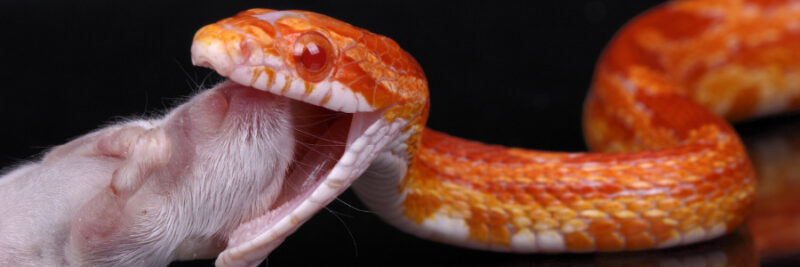
In captivity, corn snakes will eat only meat in the form of rodents from breeders who produce frozen then thawed mice or rats. Never offer live rodents which can bite and seriously harm snakes.
Here are best practices on feeding frequency, techniques and what to monitor regarding appetite changes:
How Much & How Often
- Hatchling snakes – 1 pinky mouse every 5 to 7 days
- Adult snakes – Can handle adult mouse or hopper rat sized meals every 7 days
- Water bowl should always be available
Feeding Technique
Use long feeding tongs to grip head of thawed pinky, wiggle in front of the snake and release when they strike and coil to constrict. Never leave unsupervised with live prey.
Monitoring Appetite
Note any significant changes in typical eating patterns which can indicate illness like mouth rot. Snakes in shedding cycle often go off food for awhile. Bulges mid-body means regurgitation issue requiring vet.
Handling & Taming Your Snake
Becoming comfortable interacting with and holding your pet snake leads to enjoyable experiences for both owner and snake when done properly and consistently. Here’s how to form trust with your corn snake:
Let Them Adjust
For the first ~5-7 days, resist handling to allow adjustment to their new home and reduce relocation stress. Observe behaviors and feeding from outside the habitat instead.
Start Handling
After about 1 week, begin attempting to handle in 10 minute sessions, 2 to 3 times per week. Be slow, gentle yet confident in your movements so the snake feels secure.
Handling Technique
Support the middle of the snake’s long body with both hands cradled underneath, positioned equally across the length. Do NOT tightly squeeze or restrain. Allow them to loosely move through your hands inspection surroundings yet feeling secure.
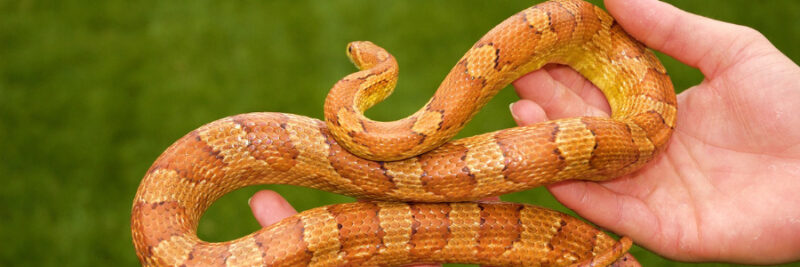
Taming Takes Patience
With regular, gentle handling most corn snakes will become quite docile and tolerant of human interaction. But the taming process takes consistency and patience over many weeks. Progress at their pace and be watchful for signs of fear like sudden erratic motions, tight coiling, biting or muscle tension since snakes cannot vocalize audibly! Should they display stressed behaviors, pause handling to let them regain comfort before resuming.
Signs of Health Issues in Corn Snakes
While hardy snakes compared to other species when set up properly, corn snakes can still develop certain husbandry related illnesses, shedding problems or parasites requiring veterinary assistance if not corrected. Here is what to watch for:
Illness Symptoms
- Wheezing, coughing – respiratory infection
- Oozing eyes/mouth, bad smell – mouth rot
- Balloon-like swelling – blister disease
- Skin blisters, lesions – snake mites
- Weight loss, lethargy
- Regurgitation of meals
Shedding Issues
- Shed skin stuck on body in pieces – humidity too low
- Abnormal skin coloration
- Eye caps not shedding off head
Schedule annual checkups plus prompt vet visits if abnormal symptoms are spotted. Provide immediate assistance for regurgitation, wheezing, oozing eyes/mouths and mites which can worsen rapidly.
Enrichment & Habitat Maintenance
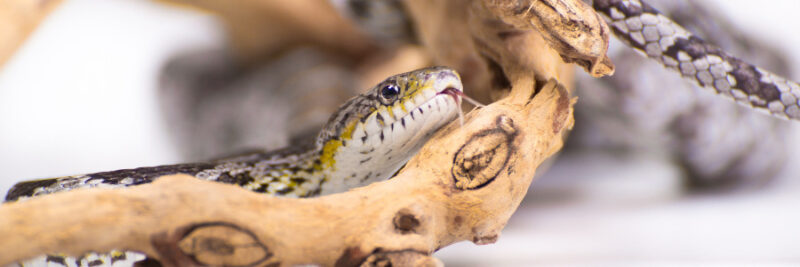
Part of the fun of having a pet snake is catering their environment to tap into their wild instincts and behaviors! Corn snakes especially benefit from opportunities supporting natural enrichment. Here are ideas:
Burrowing
Add additional 8 to 10 inches of loose substrate allowing them to tunnel below completely submerged.
Climbing
Add wood branch structures, fake foliage and rough textured accessories to promote muscle tone and exercise through climbing.
Exploring
Rearrange accessories monthly to create “new” spaces to discover like a faux underground rock cave added. Watch them investigate!
Cleanliness is also key to prevent bacterial blooms. Follow this maintenance schedule:
- Daily spot clean waste
- Monthly full substrate change
- Disinfect entire tank between snake occupants
Lastly, be watchful for any signs of decreased appetite, unusual behavior changes or symptoms above indicating sickness needing attention. Stay involved and get to know individual snake’s personality quirks so you can act as their health advocate, providing the best life possible for your new scaly family member!
Corn Snake Care FAQs:
Absolutely! As covered in detail above, corn snakes are highly recommended beginner friendly snakes due to their generally calm temperament and comparatively lower care level demands. Their smaller size also makes them a more manageable starter snake before potentially tackling larger snake species.
Avoid loose substrates like sand or dirt which can harm when consumed during burrowing and impaction risk. Steer clear of cedar as it releases fumes toxic to snakes. Any decor items with sharp facets or edges pose injury risks. Lastly avoid keeping corn snakes at sustained temperatures over 90°F which causes thermal stress.
It's important to give your new snake approximately 1 week minimum of adjustment time in their new habitat before attempting initial gentle handling sessions. Not only does relocation stress snakes, but starting handling too soon can contribute to a longer taming down process. Take it slow!
Great items to include are 2 snug hide boxes (warm and cool side), climbable branches, artificial foliage, cork tubes, and items enabling burrowing several inches down like aspen bedding. Having both a temperature and enrichment gradient fulfills a corn snake's needs allowing them to thermoregulate, feel secure and exhibit innate behaviors
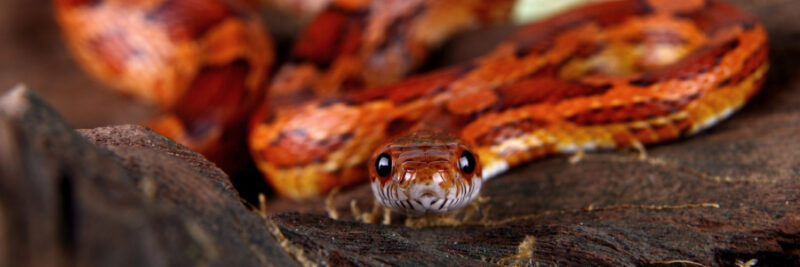
For any additional questions on welcoming home and caring for pet corn snakes as beginners, consult an exotic reptile veterinarian. When set up properly with consistent maintenance, corn snakes make fantastic starter snakes sure to bring years of enjoyment observing their behaviors evolve as you form a bond together!
